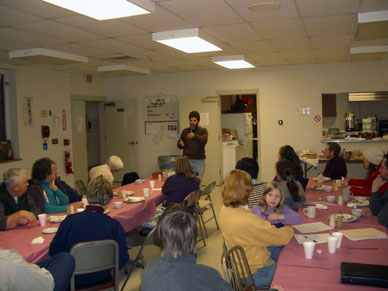February 01, 2004
Calming traffic on rural roads
I went to West Danby last night to hear a presentation that seems very relevant to issues in Dryden. Fernando de Aragon, the Executive Director of the Ithaca-Tompkins County Transportation Council, gave a presentation - which in many ways was a conversation with attendees - on calming traffic on rural roads.

Fernando de Aragon presents rural road calming strategies at the West Danby Community Association.
Aragon noted that highway design has changed a bit over the past few years, as more people have to realize that having a single model for roads designed to get the most traffic through isn't appropriate. He noted two publications in particular, Design Guides for Rural Roads and Flexibility in Highway Design, as providing other options for highway designers.
He also suggested that the New York Department of Transportation (DOT) is more obligated to take community concerns into account, through primarily at the beginning of major new road work, which only happens every twenty years or so, and mentioned Context-Sensitive Solutions (CSS), a project at the DOT that includes:
a philosophy wherein safe transportation solutions are designed in harmony with the community. CSS strives to balance environmental, scenic, aesthetic, cultural and natural resources, as well as community and transportation service needs. Context sensitive projects recognize community goals, and are designed, built and maintained to be sustainable while minimizing disruption to the community and the environment.
Traffic calming techniques (which may be part of CSS but can also be done separately) make drivers slow down by presenting drivers with minor challenges rather than by putting up speed limit signs or traffic lights. Speed bumps and speed humps are classic calming tools, though they work poorly at higher speeds and can cause problems for heavy vehicles, including emergency vehicles. More sophisticated approaches (which require rebuilding the road) can use more subtle shifts in the banking and elevation of the road to make drivers wary. Reducing the driver's field of vision with shrubs and bushes or increasing the amount of horizontal shifting they have to do can also help.
The West Danby residents were largely concerned about NY Route 34/96, which has seen a number of chemical spills and which presents residents with a wide variety of challenges at intersections and driveways. The volunteer fire station there has strobes to warn drivers of emergency vehicles coming out, but that's not a widely-available strategy for getting people out of their driveways.
West Danby volunteer fireman John Smith did note, however, that 34/96 may already have a traffic-calming effect because of its relatively higher number of curves and warning signs, and it apparently has a much lower rate of fatal accidents than the straighter routes 13 through Newfield and 96B through Danby. Many people there still perceived speeding to be a problem, particularly during rush hours. As Aragon noted, Tompkins County employs about 14,000 people from surrounding counties, which creates much larger commuter pressure than most counties have to deal with.
Joel Gagnon asked how to talk with the state about the road. Apparently towns can go directly to the DOT with concerns about state roads, while they have to go to the county and the county to the DOT for county roads.
Aragon suggested assembling a report on the road, noting problems and intersections and collecting data on traffic volumes and speed. Apparently the Town of Ithaca has invested in a traffic measuring device that collects speed information as well as counting the number of cars that pass, though an attendee noted that people tend to slow down when they see the black ropes across the road. Aragon emphasized that hard data makes it much easier to get a case through the DOT. In particular, he noted that "Safety is one of the key ways of tickling New York DOT."
Speed enforcement is a challenge on 34/96 as there are few places for police to hide and few places to pull drivers over safely. Parking cars that look like police cars along the road was one suggestion, but without a village and the dedicated police that brings - I think that the police force in the Villages of Dryden and Freeville, for instance, has a substantial impact on speeds on their roads - enforcement is both spotty and has its own substantial costs.
Polley Smith suggested that signs welcoming people to West Danby might at least let people know they were in a place with population, and could combine beautification and a sign of community with some hope that drivers would slow down. (Varna is working on something similar.) Aragon said that it couldn't hurt and might help. There was also a suggestion of putting in pedestrian crosswalks, but apparently crosswalks without lights give pedestrians a false sense of security while not changing drivers' perspectives very much.
I can't say I left the meeting feeling too optimistic about changes to our road structures that will make it any easier to sustain communities here, but it was a very impressive evening. Community associations or even the Town Board here might want to schedule a similar session, as it really cleared up a lot of questions I had about who is responsible for roads, what can be done to modify roads, and how the balance between throughput and impact on a community gets looked at these days.
Posted by simonstl at February 1, 2004 08:42 AMNote on photos